There are plenty of lists of greatest video games or video game Hall of Fames out there, but the fine folks at Gaming Alexandria wanted to take our own stab at this process. These are the Video Game Notables for 2022, a constantly updating list of important games that we feel deserve to be in any conversation about the medium!
In looking at many different canon selections within different media, we identified a few problems with starting a new list that we wished to rectify when starting up the Video Game Notables:
- If inductions only take place once a year, it will be a few years to get the “obvious” inductees out of the way, which drains enthusiasm for the project.
- Restrictions on dating and criteria tend to reflect the bias of a strong minority within the organization.
- With first-past-the-post voting systems it’s very difficult to form a rallying point around candidates which are not at the very top of notability in the general public.
The way we solved these problems helped to create a hopefully equitable and different version of a list of notable video games!

The primary way we did things different was by introducing Ranked Choice Voting, which is noted by mathematicians and voting officials to be a much more favorable system to a broader base of a people. In brief: You select an arbitrary number of candidates and rank them according to your preference. This video by CGP Grey introduced me to the concept and we adopted it into our formal voting.
Before we did the ranked voting though, we convened with a group of interested people to sort out the “Automatic Ins”, the group of games which would reflect the views of the assembled people and fill out the first two years of nominees. We settled on a number of twelve games, which meant that each subsequent vote for the year would induct six games into the Video Game Notables. Why not five? Six is better!
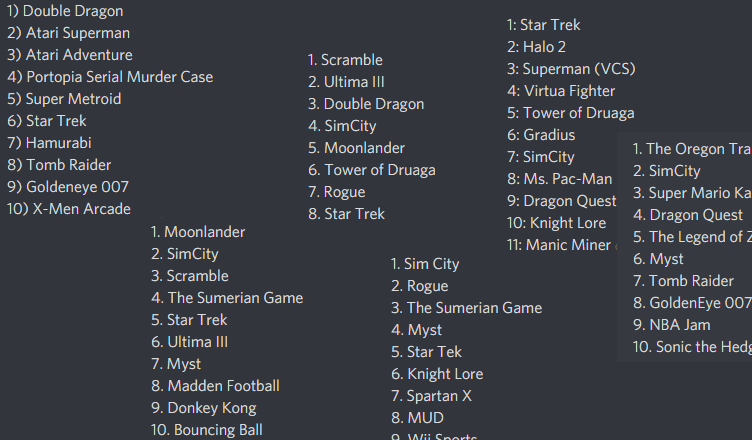
We did the twelve initial votes in mid-2021 and then the six from a ranked choice voting system at the end of 2021. Ultimately this feels like it solves most of the frustrating issues with the standard hall of fame voting system and has produced some interesting results. By rallying behind a candidate, even if they are ranked low by various individuals, the amount of votes tends to matter more than the placement. Some games catapulted up to the cutoff point for the six games compared to the initial scoring due to somebody making a strong case for their inclusion!
Below, we present the results of this voting. The first twelve are from the initial council voting and the remaining six were voted on by anybody who wanted to participate in the Gaming Alexandria Discord server, which you can also join! A livestream video announcing and discussing all of the initial winners can be found here.
Additional notes:
- Only specific games can be inducted for these slots. No series, no platforms, no people or companies. The platform of the game in question must be specified.
- If a game was actively produced by six or less people, they are listed on the placard. If more than that worked on the final product, they will be referred to as a studio. The exception will be if a game has a notable original creator, as in the case of Tetris.
- The write-ups below reflect the view of the author as to why the game is important, which is not shared by all participants. Watch the livestream video for some variant opinions on why the game was added to the Video Game Notables.
- Agree to disagree! 🙂
I hope you enjoy the first of of many reports about the games entered into the Video Game Notables!
Initial Inductees
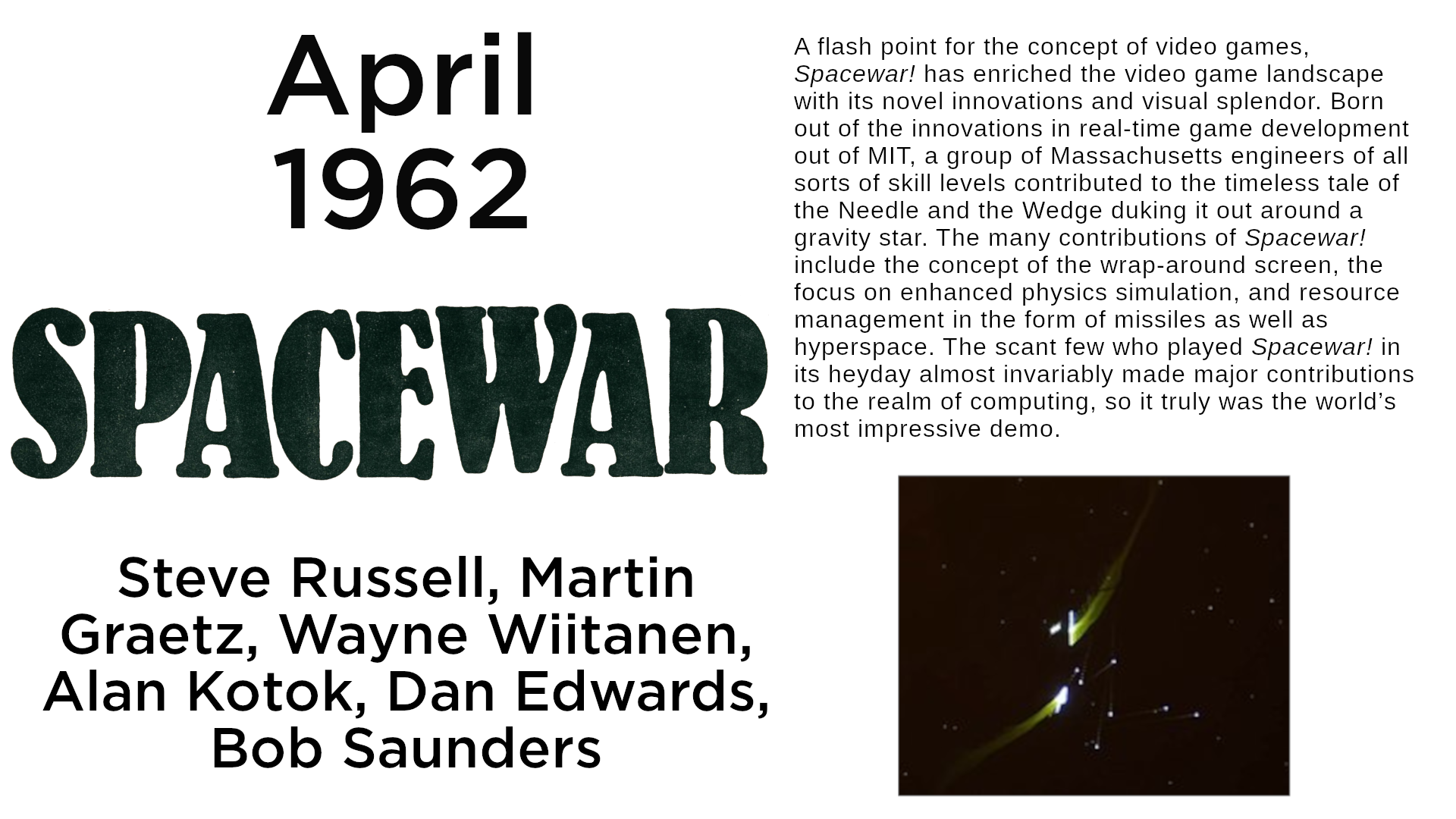
A flash point for the concept of video games, Spacewar! has enriched the video game landscape with its novel innovations and visual splendor. Born out of the innovations in real-time game development out of MIT, a group of Massachusetts engineers of all sorts of skill levels contributed to the timeless tale of the Needle and the Wedge duking it out around a gravity star. The many contributions of Spacewar! include the concept of the wrap-around screen, the focus on enhanced physics simulation, and resource management in the form of missiles as well as hyperspace. The scant few who played Spacewar! in its heyday almost invariably made major contributions to the realm of computing, so it truly was the world’s most impressive demo.
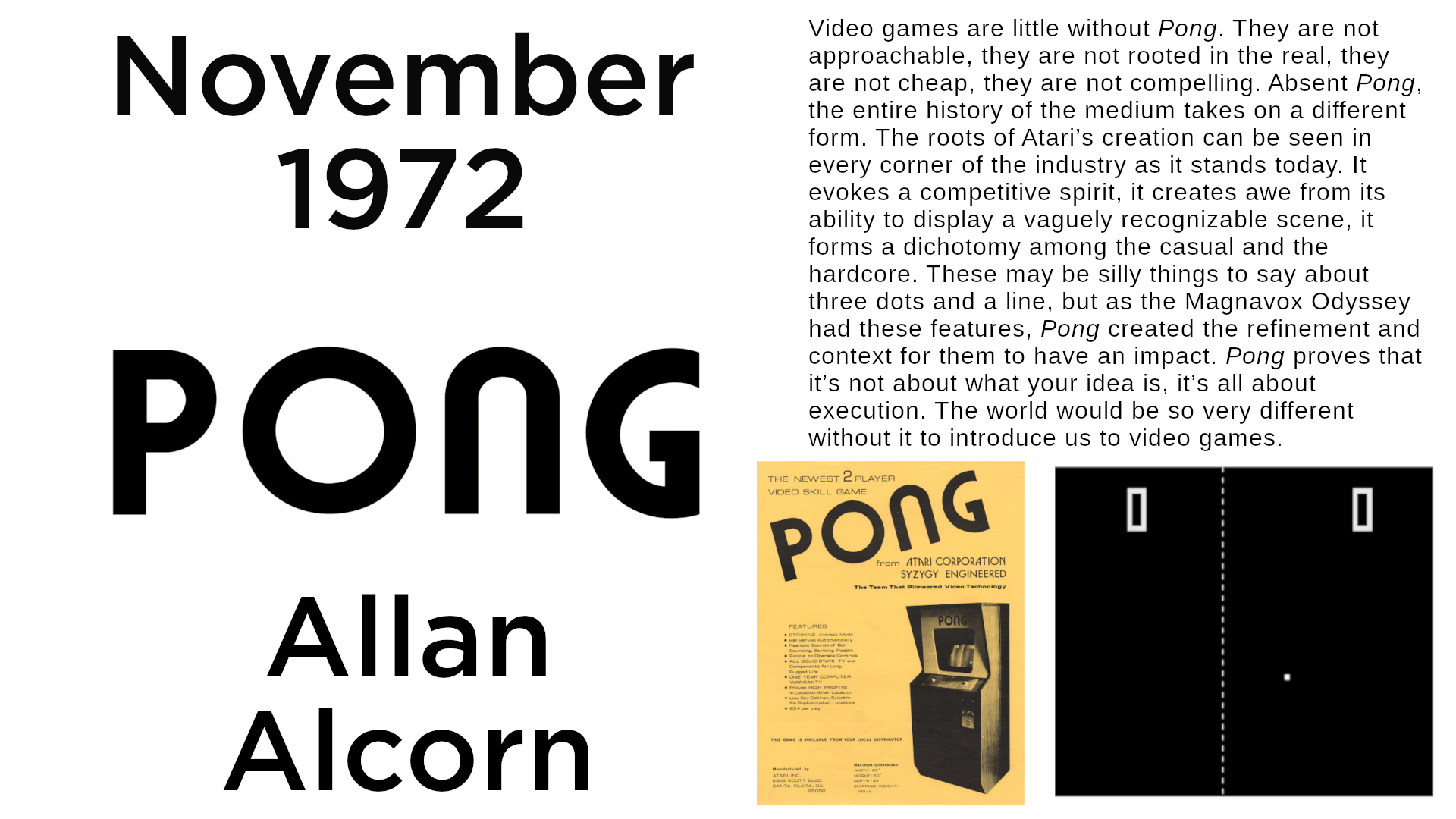
Video games are little without Pong. They are not approachable, they are not rooted in the real, they are not cheap, they are not compelling. Absent Pong, the entire history of the medium takes on a different form. The roots of Atari’s creation can be seen in every corner of the industry as it stands today. It evokes a competitive spirit, it creates awe from its ability to display a vaguely recognizable scene, it forms a dichotomy among the casual and the hardcore. These may be silly things to say about three dots and a line, but as the Magnavox Odyssey had these features, Pong created the refinement and context for them to have an impact. Pong proves that it’s not about what your idea is, it’s all about execution. The world would be so very different without it to introduce us to video games.
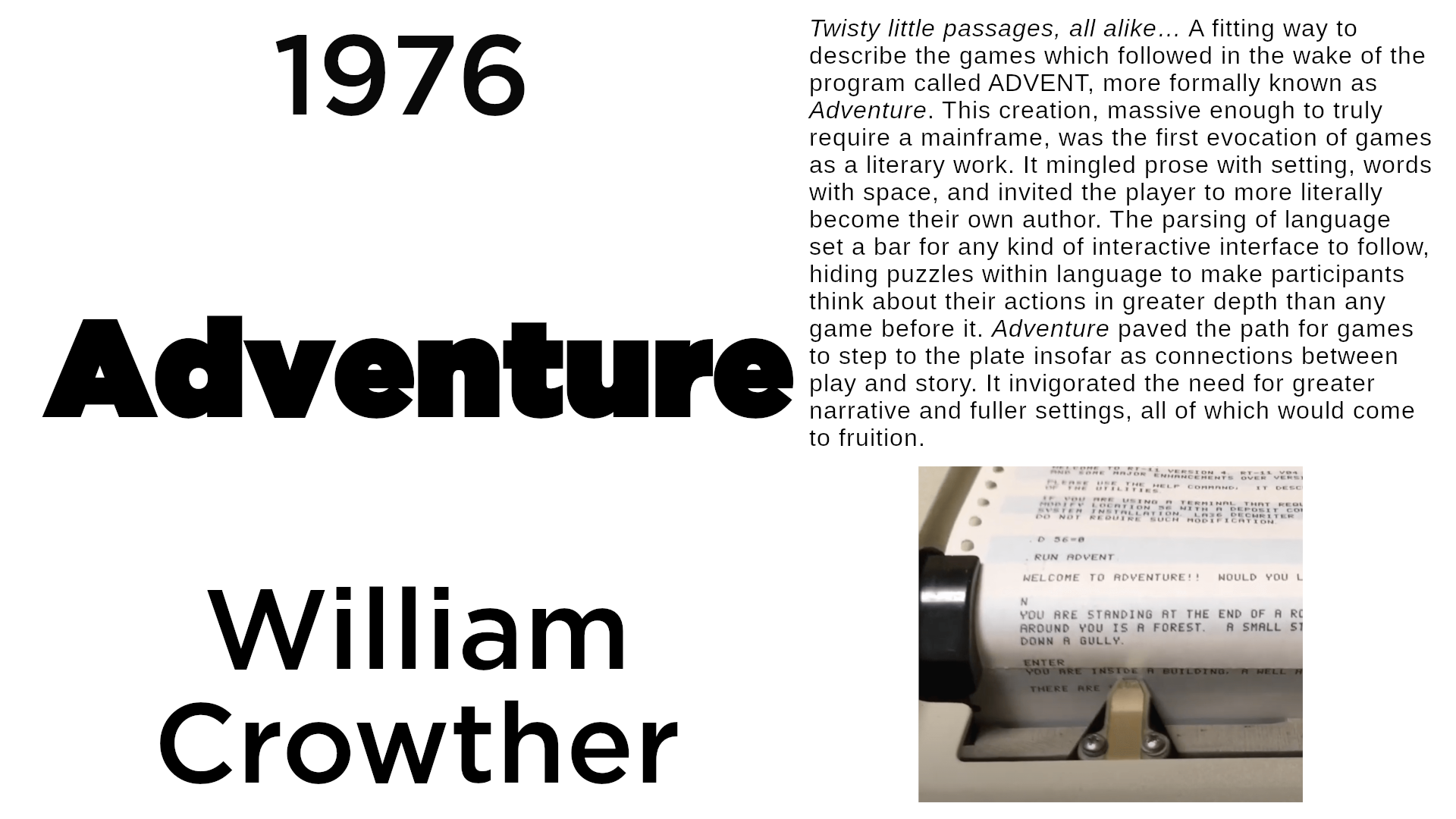
Twisty little passages, all alike… A fitting way to describe the games which followed in the wake of the program called ADVENT, more formally known as Adventure. This creation, massive enough to truly require a mainframe, was the first evocation of games as a literary work. It mingled prose with setting, words with space, and invited the player to more literally become their own author. The parsing of language set a bar for any kind of interactive interface to follow, hiding puzzles within language to make participants think about their actions in greater depth than any game before it. Adventure paved the path for games to step to the plate insofar as connections between play and story. It invigorated the need for greater narrative and fuller settings, all of which would come to fruition.
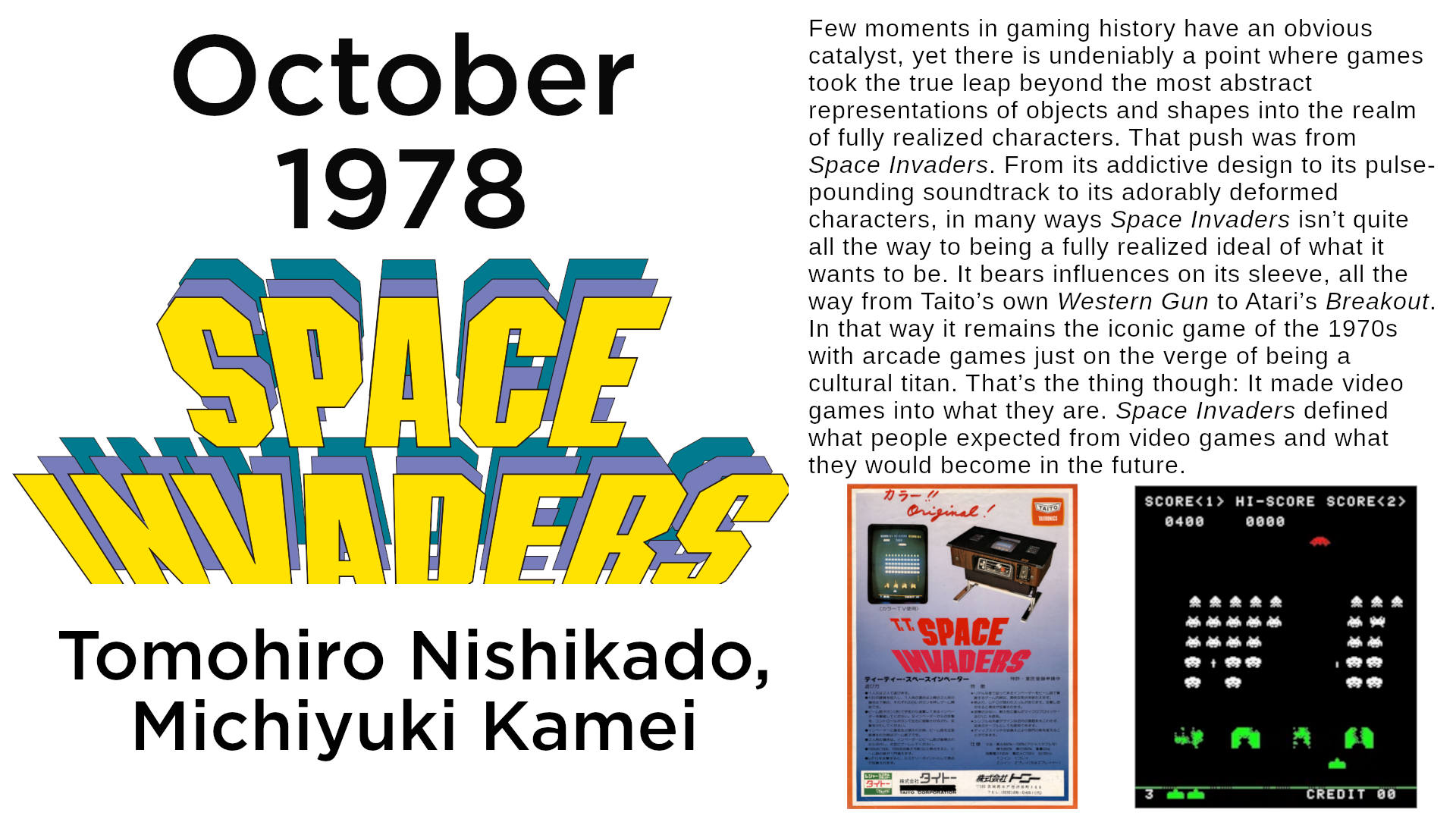
Few moments in gaming history have an obvious catalyst, yet there is undeniably a point where games took the true leap beyond the most abstract representations of objects and shapes into the realm of fully realized characters. That push was from Space Invaders. From its addictive design to its pulse-pounding soundtrack to its adorably deformed characters, in many ways Space Invaders isn’t quite all the way to being a fully realized ideal of what it wants to be. It bears influences on its sleeve, all the way from Taito’s own Western Gun to Atari’s Breakout. In that way it remains the iconic game of the 1970s with arcade games just on the verge of being a cultural titan. That’s the thing though: It made video games into what they are. Space Invaders defined what people expected from video games and what they would become in the future.
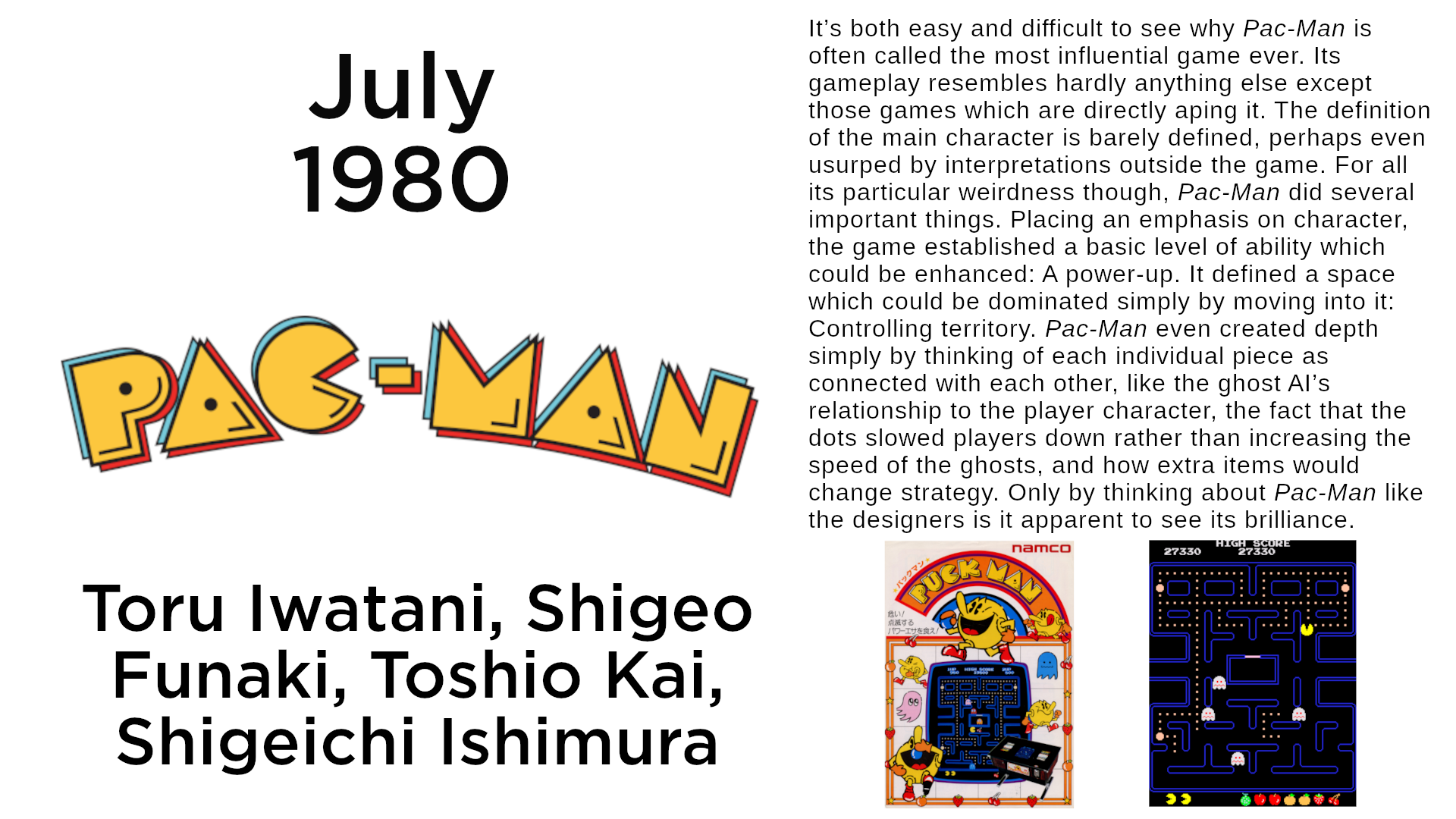
It’s both easy and difficult to see why Pac-Man is often called the most influential game ever. Its gameplay resembles hardly anything else except those games which are directly aping it. The definition of the main character is barely defined, perhaps even usurped by interpretations outside the game. For all its particular weirdness though, Pac-Man did several important things. Placing an emphasis on character, the game established a basic level of ability which could be enhanced: A power-up. It defined a space which could be dominated simply by moving into it: Controlling territory. Pac-Man even created depth simply by thinking of each individual piece as connected with each other, like the ghost AI’s relationship to the player character, the fact that the dots slowed players down rather than increasing the speed of the ghosts, and how extra items would change strategy. Only by thinking about Pac-Man like the designers is it apparent to see its brilliance.
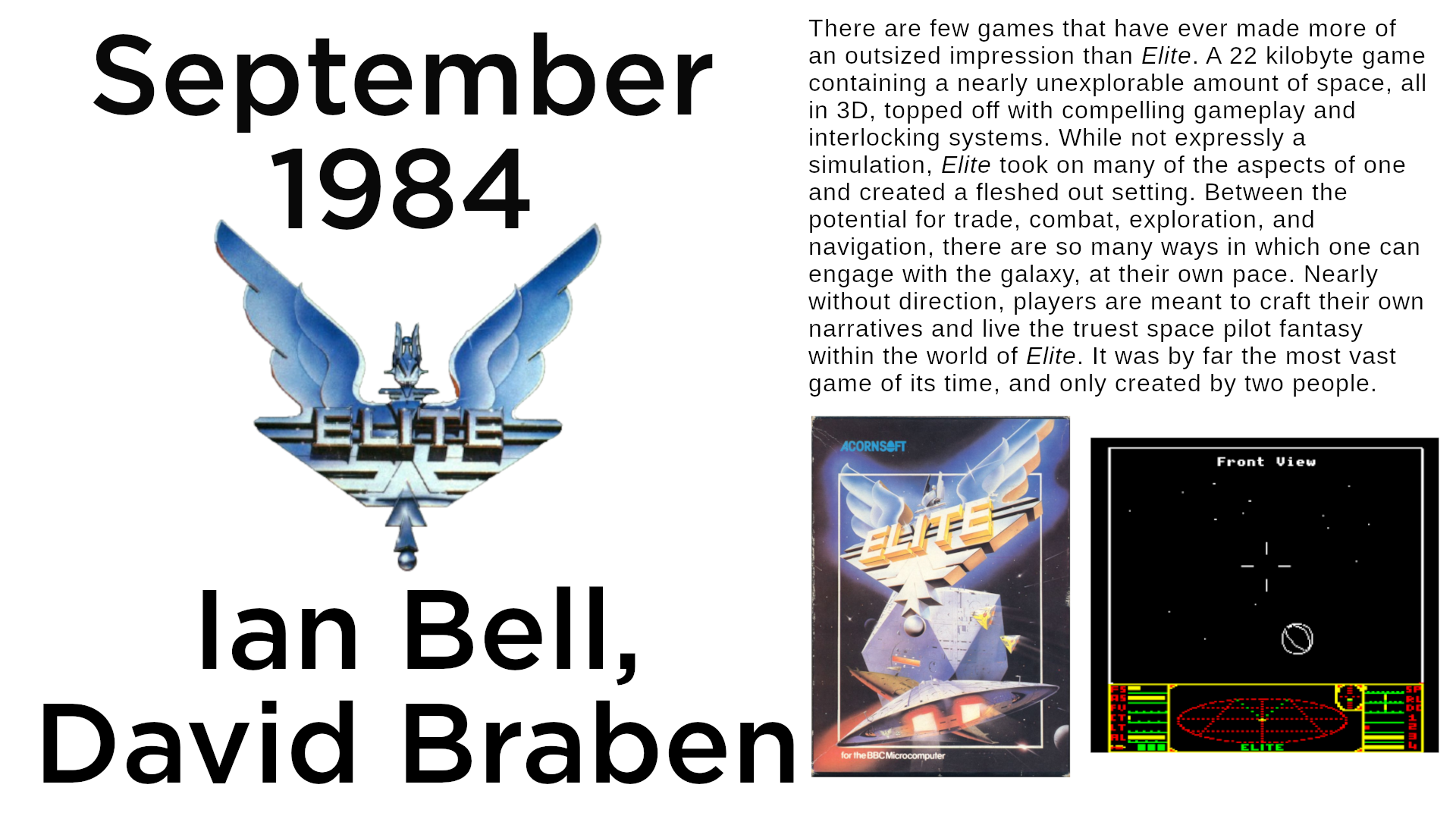
There are few games that have ever made more of an outsized impression than Elite. A 22 kilobyte game containing a nearly unexplorable amount of space, all in 3D, topped off with compelling gameplay and interlocking systems. While not expressly a simulation, Elite took on many of the aspects of one and created a fleshed out setting. Between the potential for trade, combat, exploration, and navigation, there are so many ways in which one can engage with the galaxy, at their own pace. Nearly without direction, players are meant to craft their own narratives and live the truest space pilot fantasy within the world of Elite. It was by far the most vast game of its time, and only created by two people.
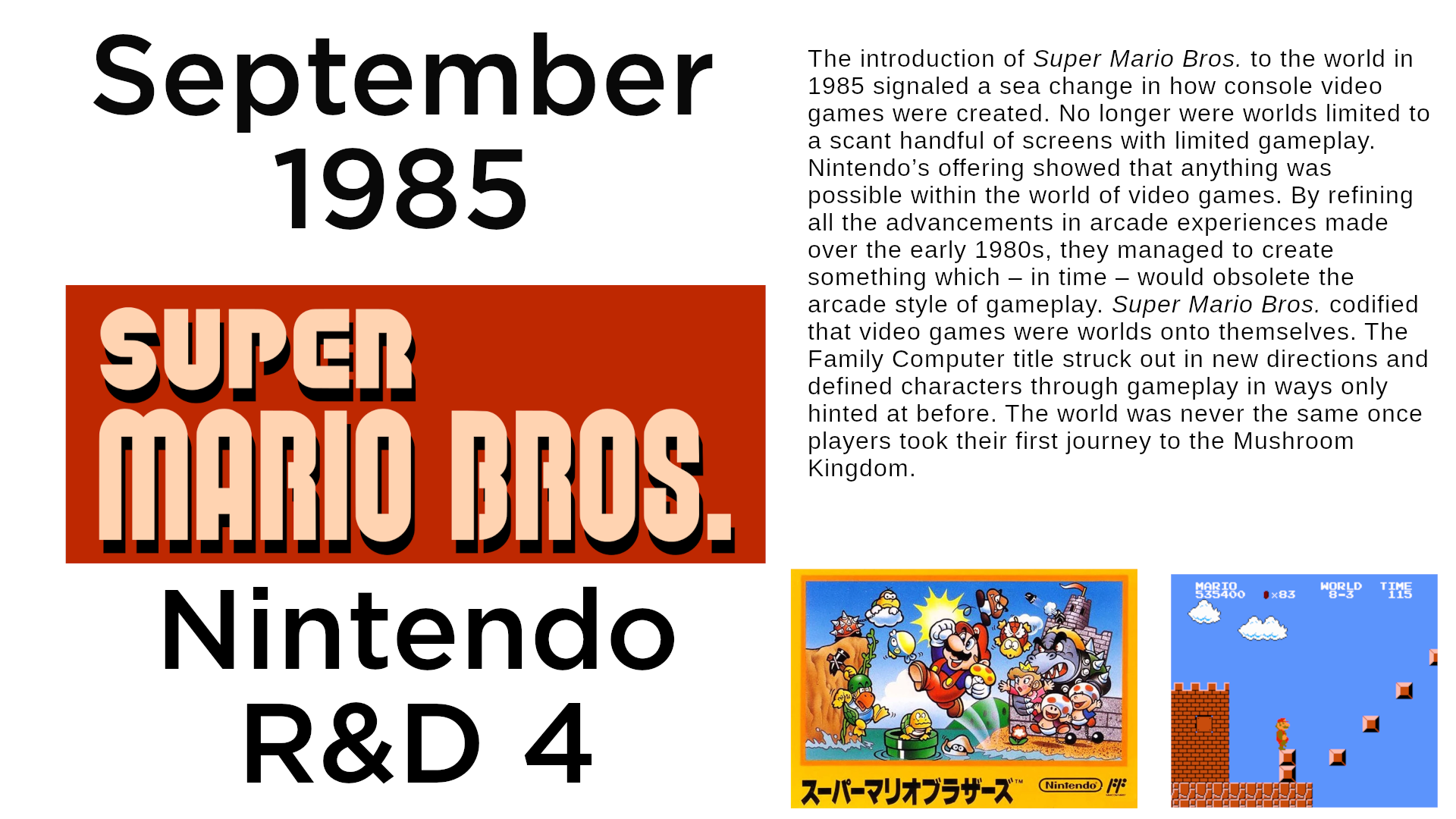
The introduction of Super Mario Bros. to the world in 1985 signaled a sea change in how console video games were created. No longer were worlds limited to a scant handful of screens with limited gameplay. Nintendo’s offering showed that anything was possible within the world of video games. By refining all the advancements in arcade experiences made over the early 1980s, they managed to create something which – in time – would obsolete the arcade style of gameplay. Super Mario Bros. codified that video games were worlds onto themselves. The Family Computer title struck out in new directions and defined characters through gameplay in ways only hinted at before. The world was never the same once players took their first journey to the Mushroom Kingdom.
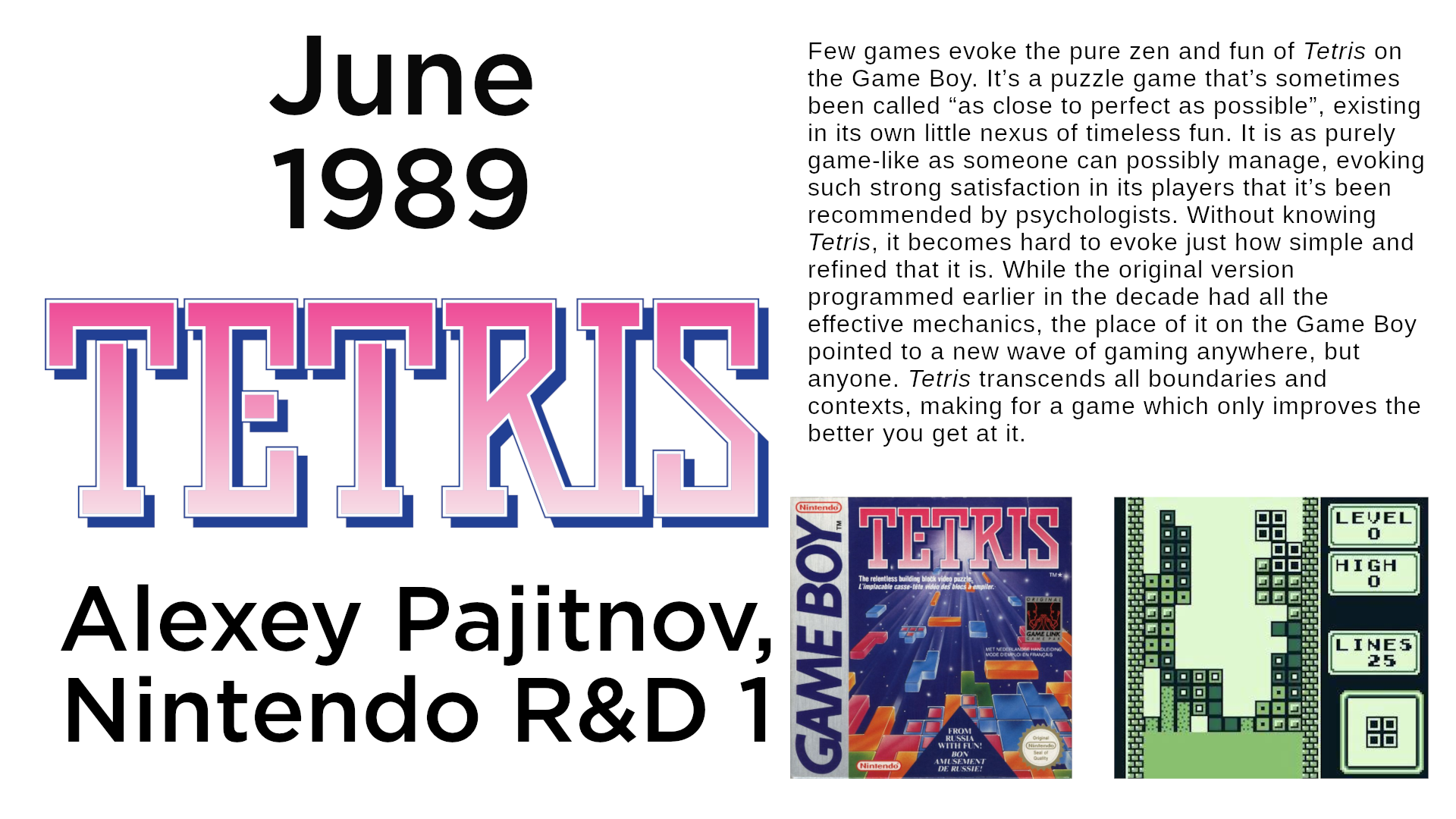
Few games evoke the pure zen and fun of Tetris on the Game Boy. It’s a puzzle game that’s sometimes been called “as close to perfect as possible”, existing in its own little nexus of timeless fun. It is as purely game-like as someone can possibly manage, evoking such strong satisfaction in its players that it’s been recommended by psychologists. Without knowing Tetris, it becomes hard to evoke just how simple and refined that it is. While the original version programmed earlier in the decade had all the effective mechanics, the place of it on the Game Boy pointed to a new wave of gaming anywhere, but anyone. Tetris transcends all boundaries and contexts, making for a game which only improves the better you get at it.
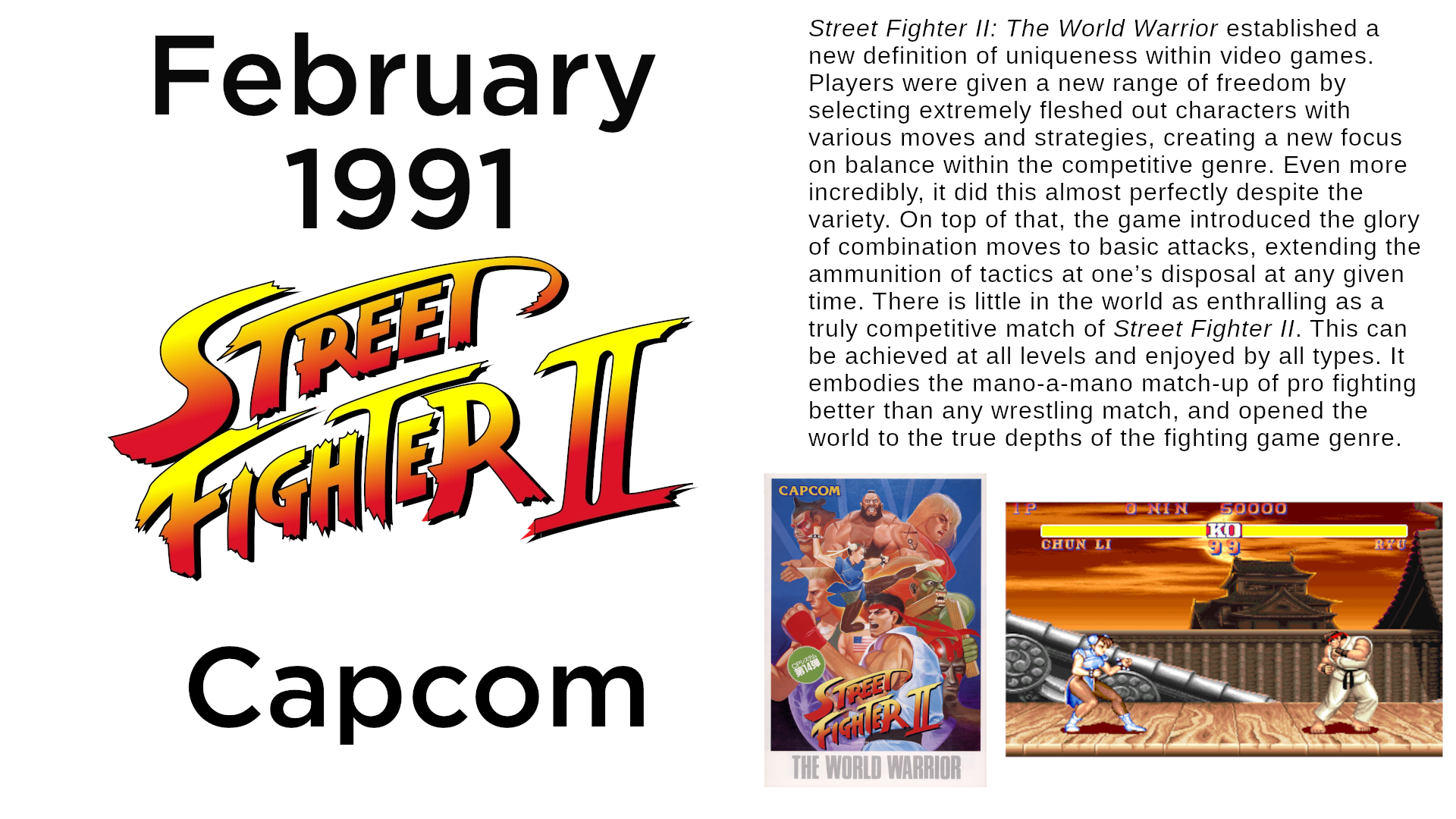
Street Fighter II: The World Warrior established a new definition of uniqueness within video games. Players were given a new range of freedom by selecting extremely fleshed out characters with various moves and strategies, creating a new focus on balance within the competitive genre. Even more incredibly, it did this almost perfectly despite the variety. On top of that, the game introduced the glory of combination moves to basic attacks, extending the ammunition of tactics at one’s disposal at any given time. There is little in the world as enthralling as a truly competitive match of Street Fighter II. This can be achieved at all levels and enjoyed by all types. It embodies the mano-a-mano match-up of pro fighting better than any wrestling match, and opened the world to the true depths of the fighting game genre.
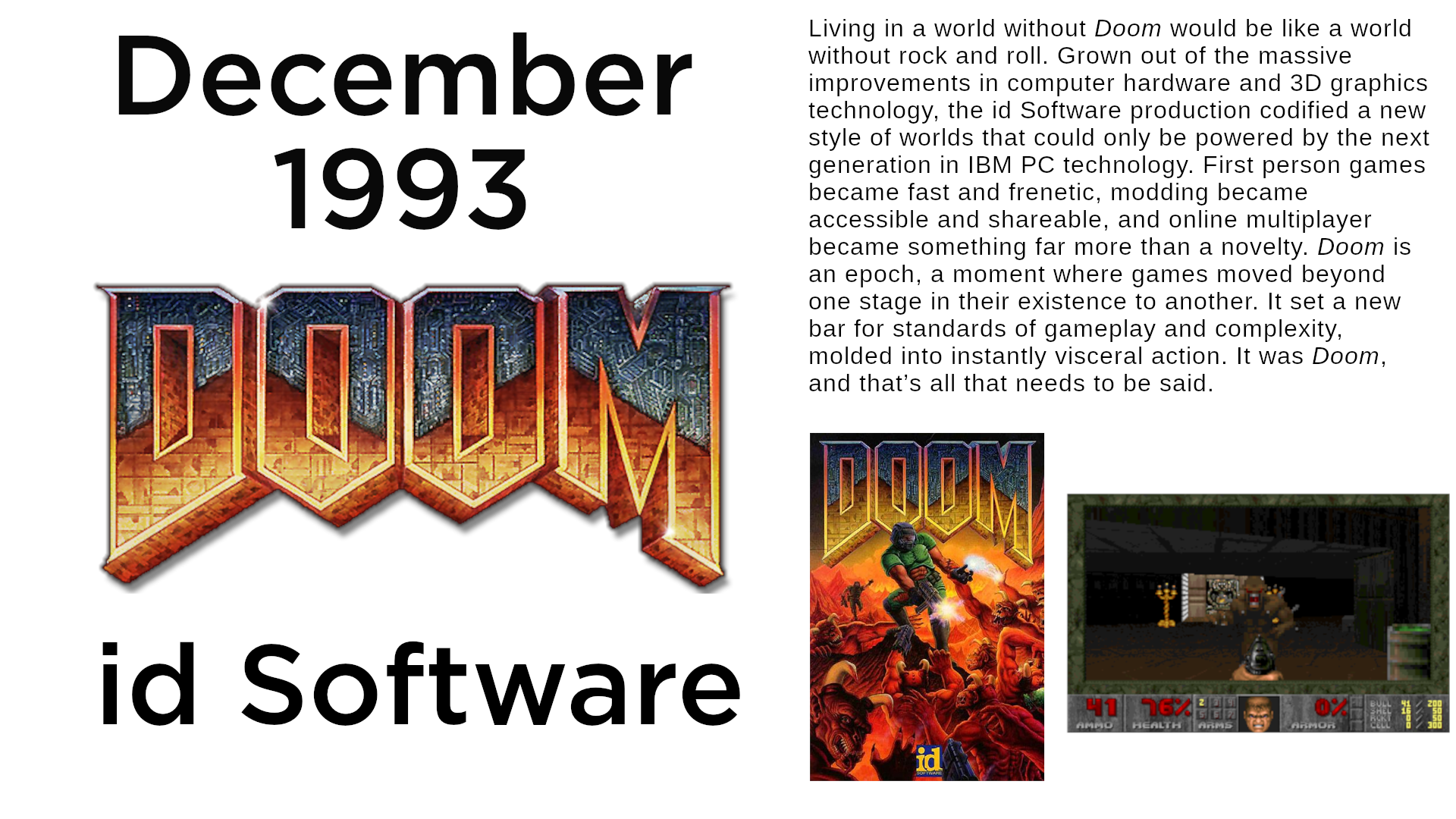
Living in a world without Doom would be like a world without rock and roll. Grown out of the massive improvements in computer hardware and 3D graphics technology, the id Software production codified a new style of worlds that could only be powered by the next generation in IBM PC technology. First person games became fast and frenetic, modding became accessible and shareable, and online multiplayer became something far more than a novelty. Doom is an epoch, a moment where games moved beyond one stage in their existence to another. It set a new bar for standards of gameplay and complexity, molded into instantly visceral action. It was Doom, and that’s all that needs to be said.
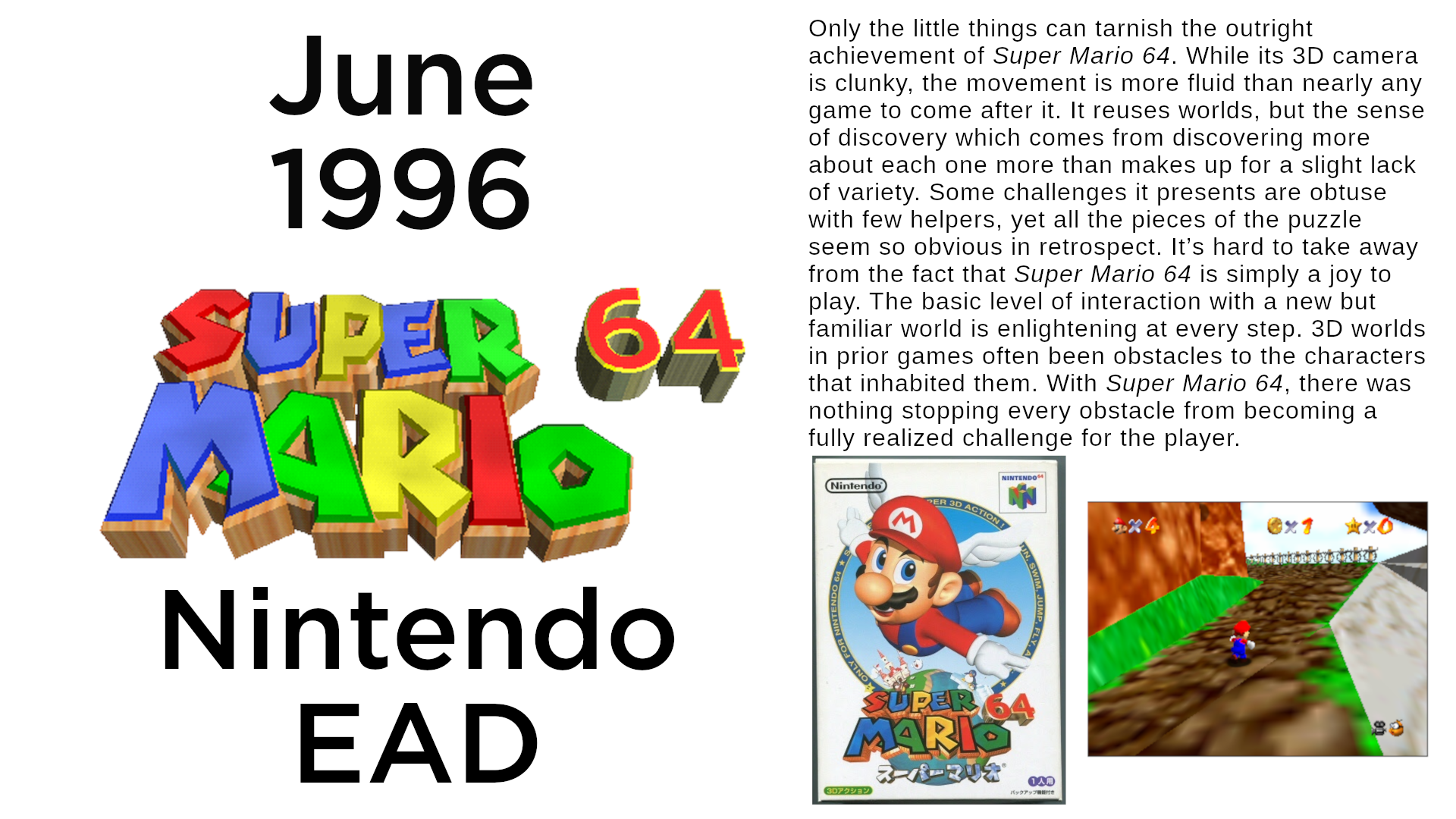
Only the little things can tarnish the outright achievement of Super Mario 64. While its 3D camera is clunky, the movement is more fluid than nearly any game to come after it. It reuses worlds, but the sense of discovery which comes from discovering more about each one more than makes up for a slight lack of variety. Some challenges it presents are obtuse with few helpers, yet all the pieces of the puzzle seem so obvious in retrospect. It’s hard to take away from the fact that Super Mario 64 is simply a joy to play. The basic level of interaction with a new but familiar world is enlightening at every step. 3D worlds in prior games often been obstacles to the characters that inhabited them. With Super Mario 64, there was nothing stopping every obstacle from becoming a fully realized challenge for the player.
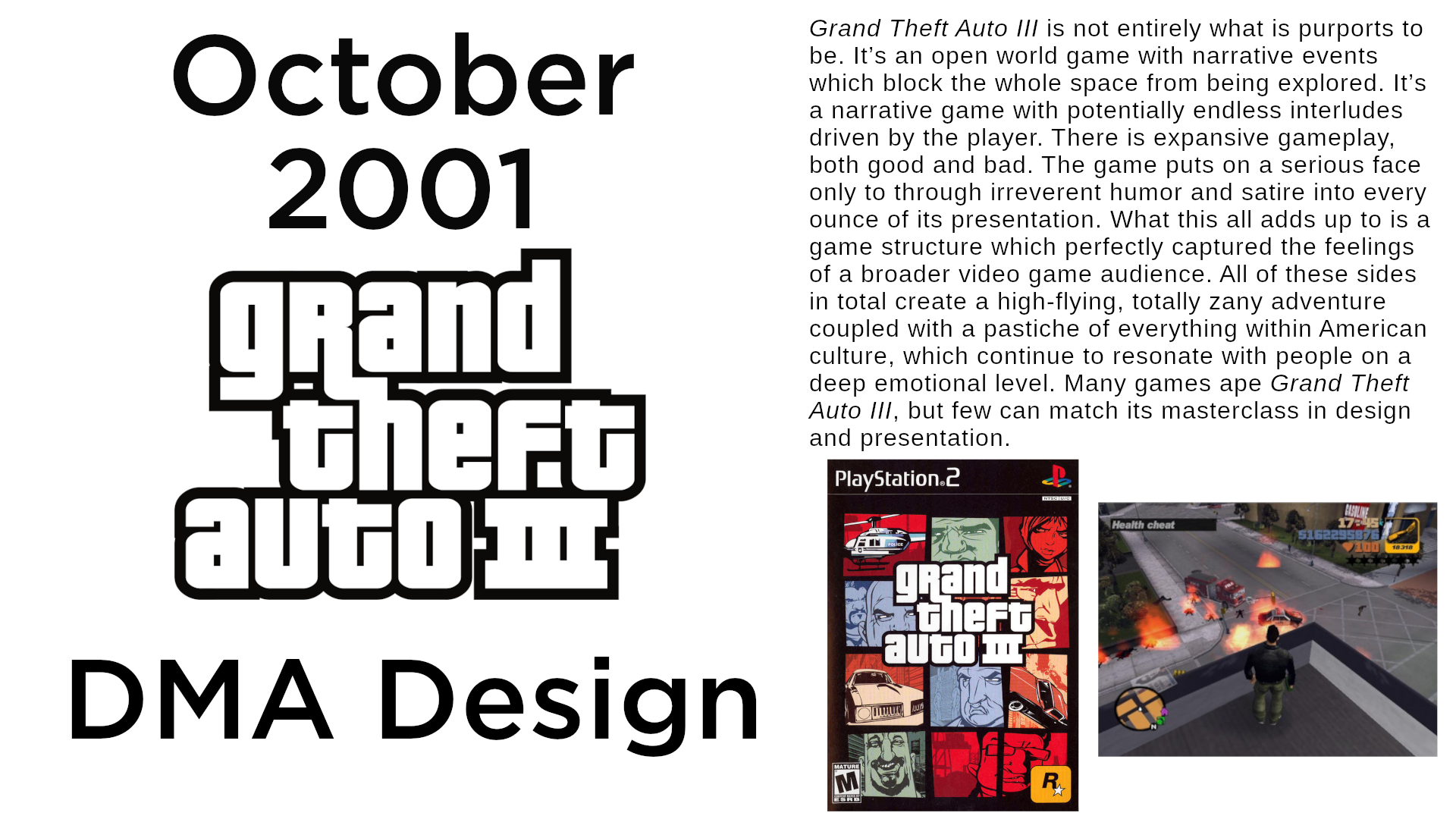
Grand Theft Auto III is not entirely what is purports to be. It’s an open world game with narrative events which block the whole space from being explored. It’s a narrative game with potentially endless interludes driven by the player. There is expansive gameplay, both good and bad. The game puts on a serious face only to through irreverent humor and satire into every ounce of its presentation. What this all adds up to is a game structure which perfectly captured the feelings of a broader video game audience. All of these sides in total create a high-flying, totally zany adventure coupled with a pastiche of everything within American culture, which continue to resonate with people on a deep emotional level. Many games ape Grand Theft Auto III, but few can match its masterclass in design and presentation.
2022 Inductees
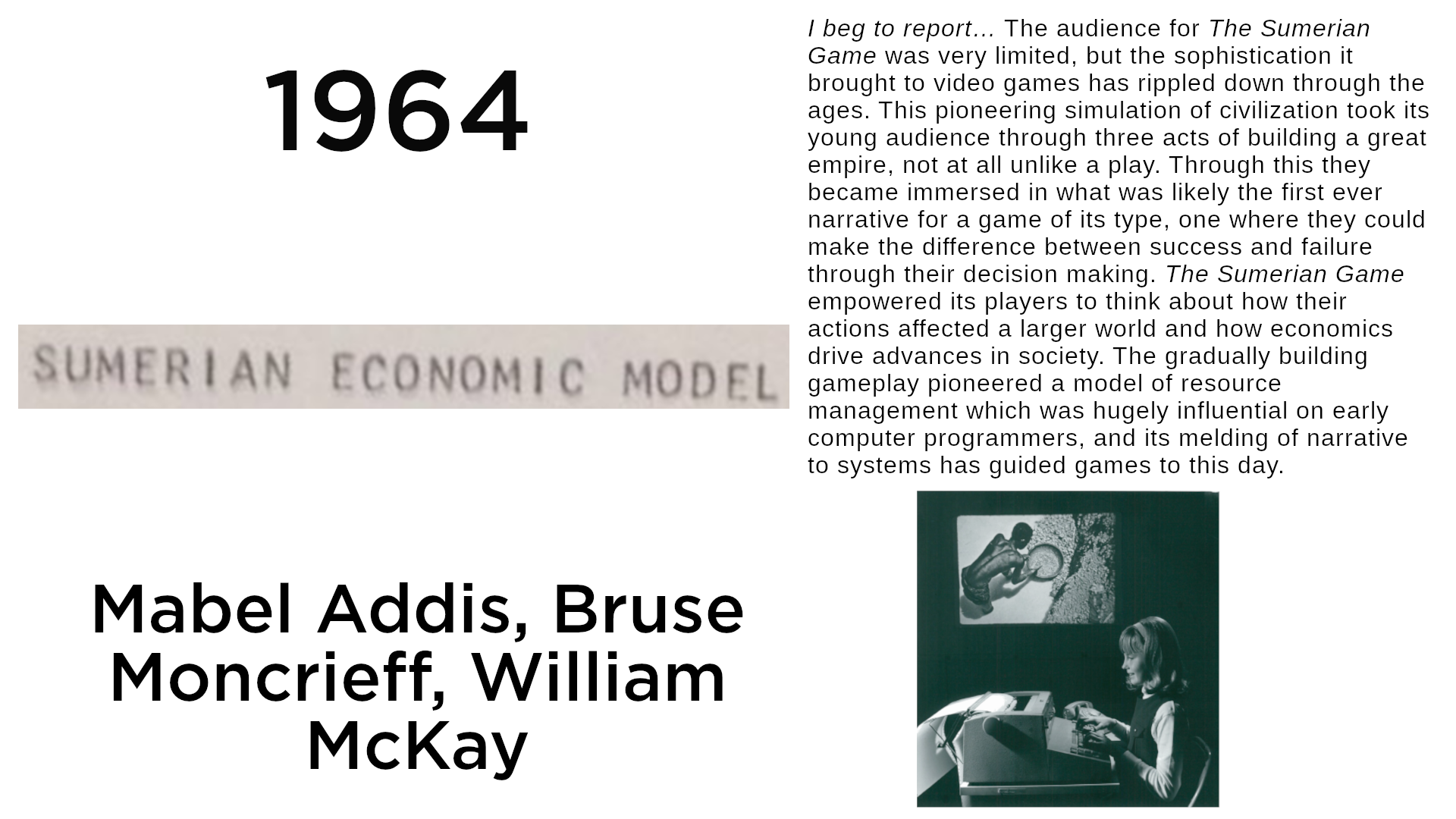
I beg to report… The audience for The Sumerian Game was very limited, but the sophistication it brought to video games has rippled down through the ages. This pioneering simulation of civilization took its young audience through three acts of building a great empire, not at all unlike a play. Through this they became immersed in what was likely the first ever narrative for a game of its type, one where they could make the difference between success and failure through their decision making. The Sumerian Game empowered its players to think about how their actions affected a larger world and how economics drive advances in society. The gradually building gameplay pioneered a model of resource management which was hugely influential on early computer programmers, and its melding of narrative to systems has guided games to this day.
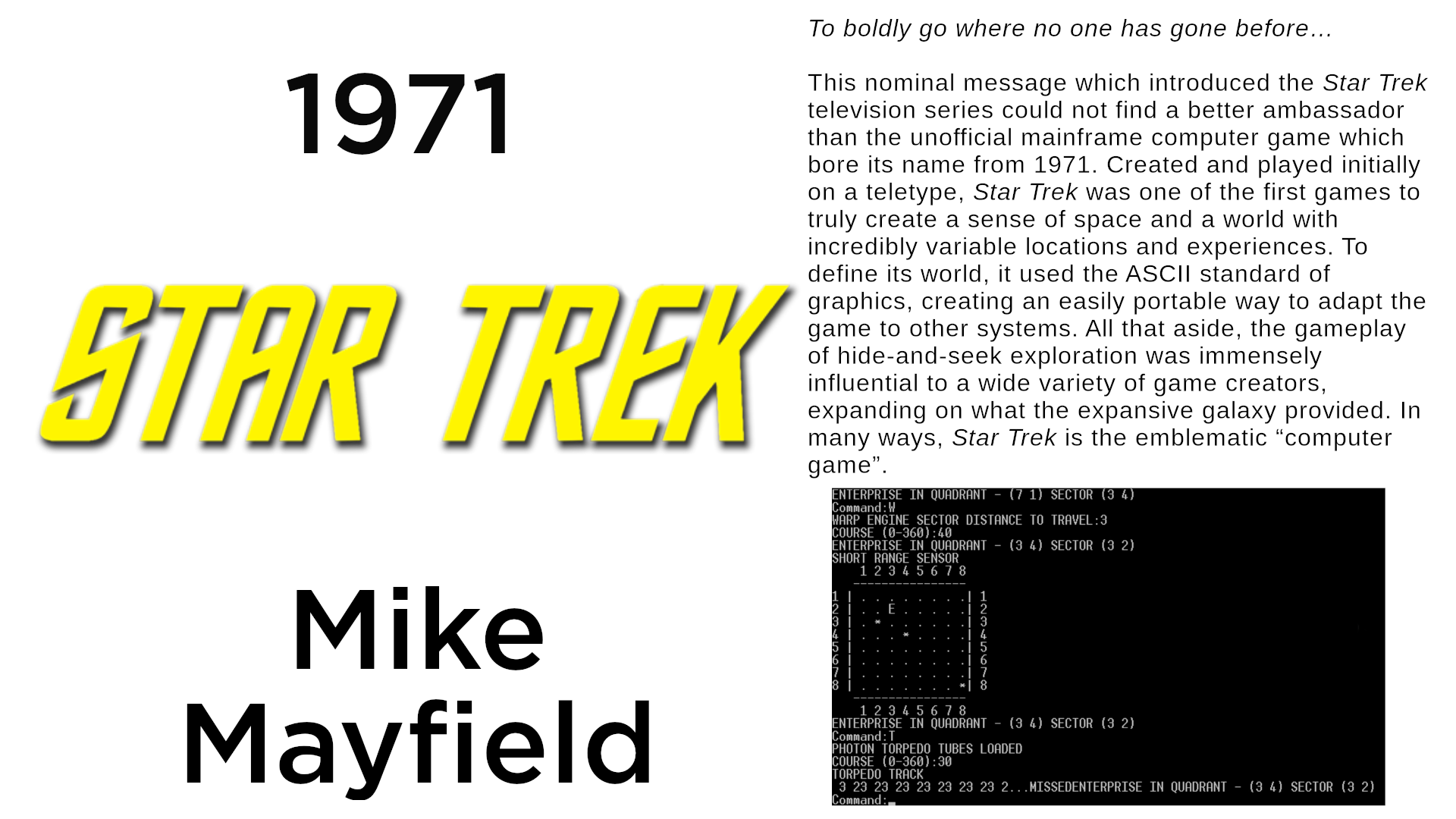
To boldly go where no one has gone before…
This nominal message which introduced the Star Trek television series could not find a better ambassador than the unofficial mainframe computer game which bore its name from 1971. Created and played initially on a teletype, Star Trek was one of the first games to truly create a sense of space and a world with incredibly variable locations and experiences. To define its world, it used the ASCII standard of graphics, creating an easily portable way to adapt the game to other systems. All that aside, the gameplay of hide-and-seek exploration was immensely influential to a wide variety of game creators, expanding on what the expansive galaxy provided. In many ways, Star Trek is the emblematic “computer game”.
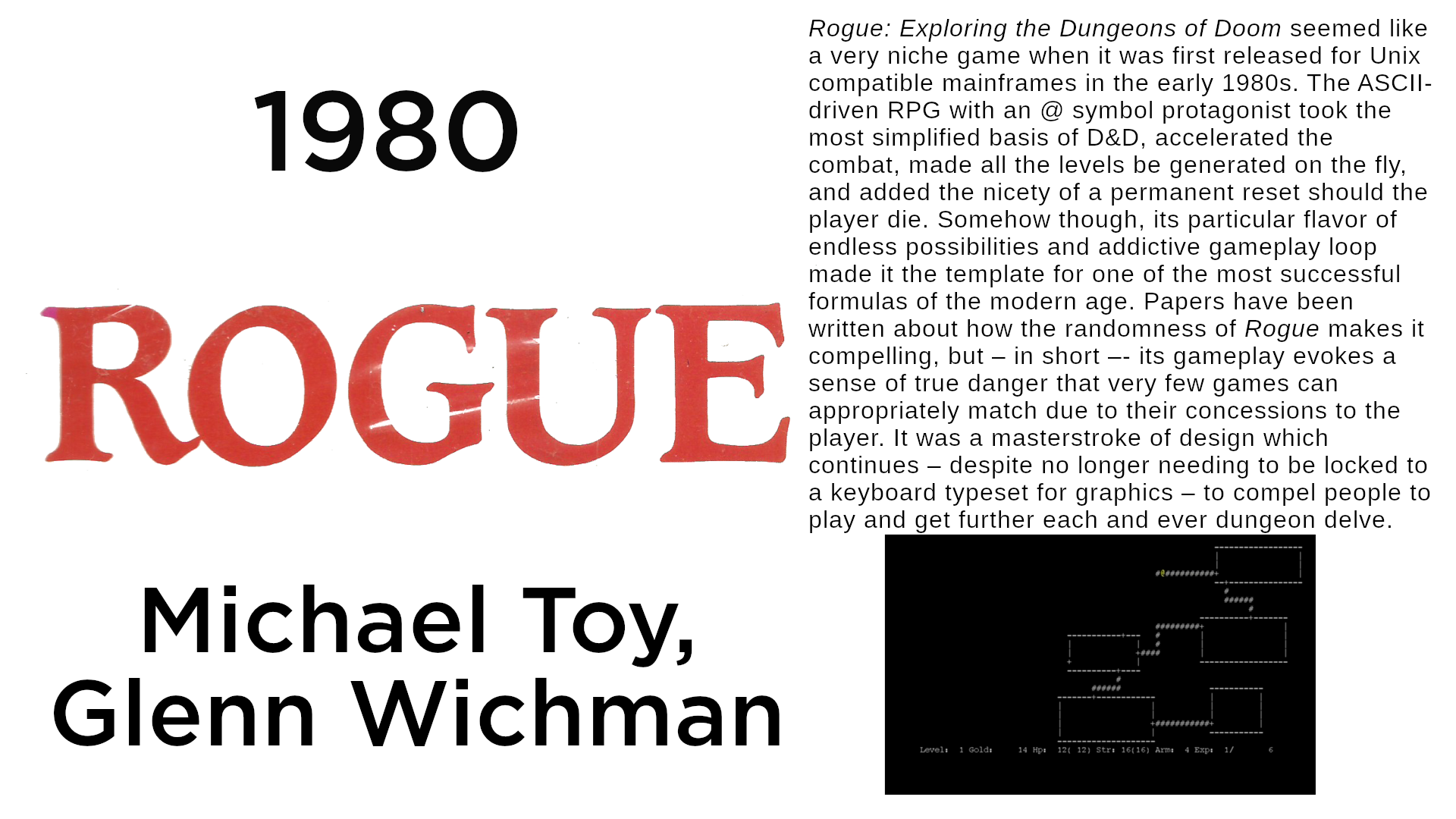
Rogue: Exploring the Dungeons of Doom seemed like a very niche game when it was first released for Unix compatible mainframes in the early 1980s. The ASCII-driven RPG with an @ symbol protagonist took the most simplified basis of D&D, accelerated the combat, made all the levels be generated on the fly, and added the nicety of a permanent reset should the player die. Somehow though, its particular flavor of endless possibilities and addictive gameplay loop made it the template for one of the most successful formulas of the modern age. Papers have been written about how the randomness of Rogue makes it compelling, but – in short – its gameplay evokes a sense of true danger that very few games can appropriately match due to their concessions to the player. It was a masterstroke of design which continues – despite no longer needing to be locked to a keyboard typeset for graphics – to compel people to play and get further each and ever dungeon delve.
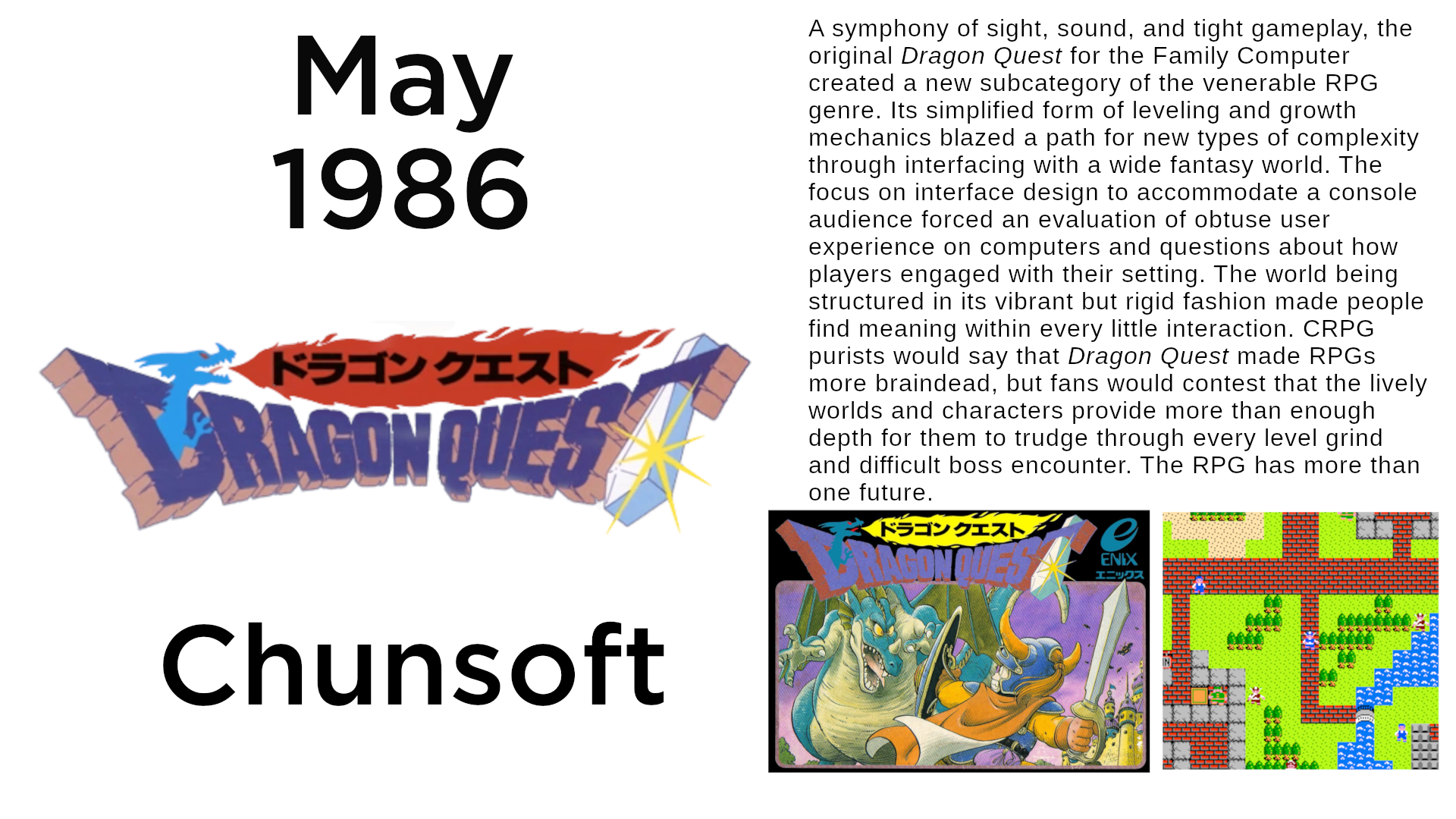
A symphony of sight, sound, and tight gameplay, the original Dragon Quest for the Family Computer created a new subcategory of the venerable RPG genre. Its simplified form of leveling and growth mechanics blazed a path for new types of complexity through interfacing with a wide fantasy world. The focus on interface design to accommodate a console audience forced an evaluation of obtuse user experience on computers and questions about how players engaged with their setting. The world being structured in its vibrant but rigid fashion made people find meaning within every little interaction. CRPG purists would say that Dragon Quest made RPGs more braindead, but fans would contest that the lively worlds and characters provide more than enough depth for them to trudge through every level grind and difficult boss encounter. The RPG has more than one future.
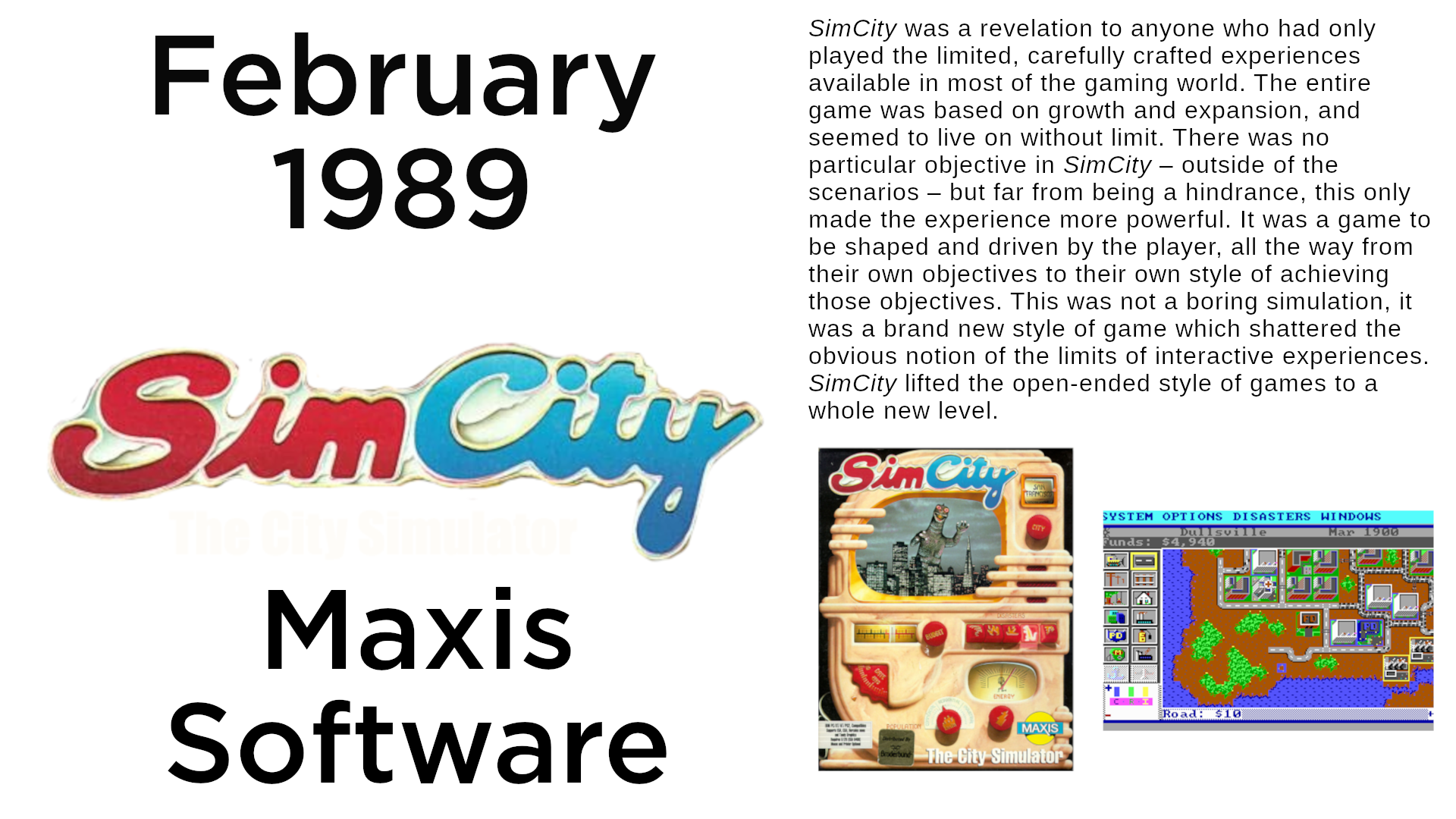
SimCity was a revelation to anyone who had only played the limited, carefully crafted experiences available in most of the gaming world. The entire game was based on growth and expansion, and seemed to live on without limit. There was no particular objective in SimCity – outside of the scenarios – but far from being a hindrance, this only made the experience more powerful. It was a game to be shaped and driven by the player, all the way from their own objectives to their own style of achieving those objectives. This was not a boring simulation, it was a brand new style of game which shattered the obvious notion of the limits of interactive experiences. SimCity lifted the open-ended style of games to a whole new level.
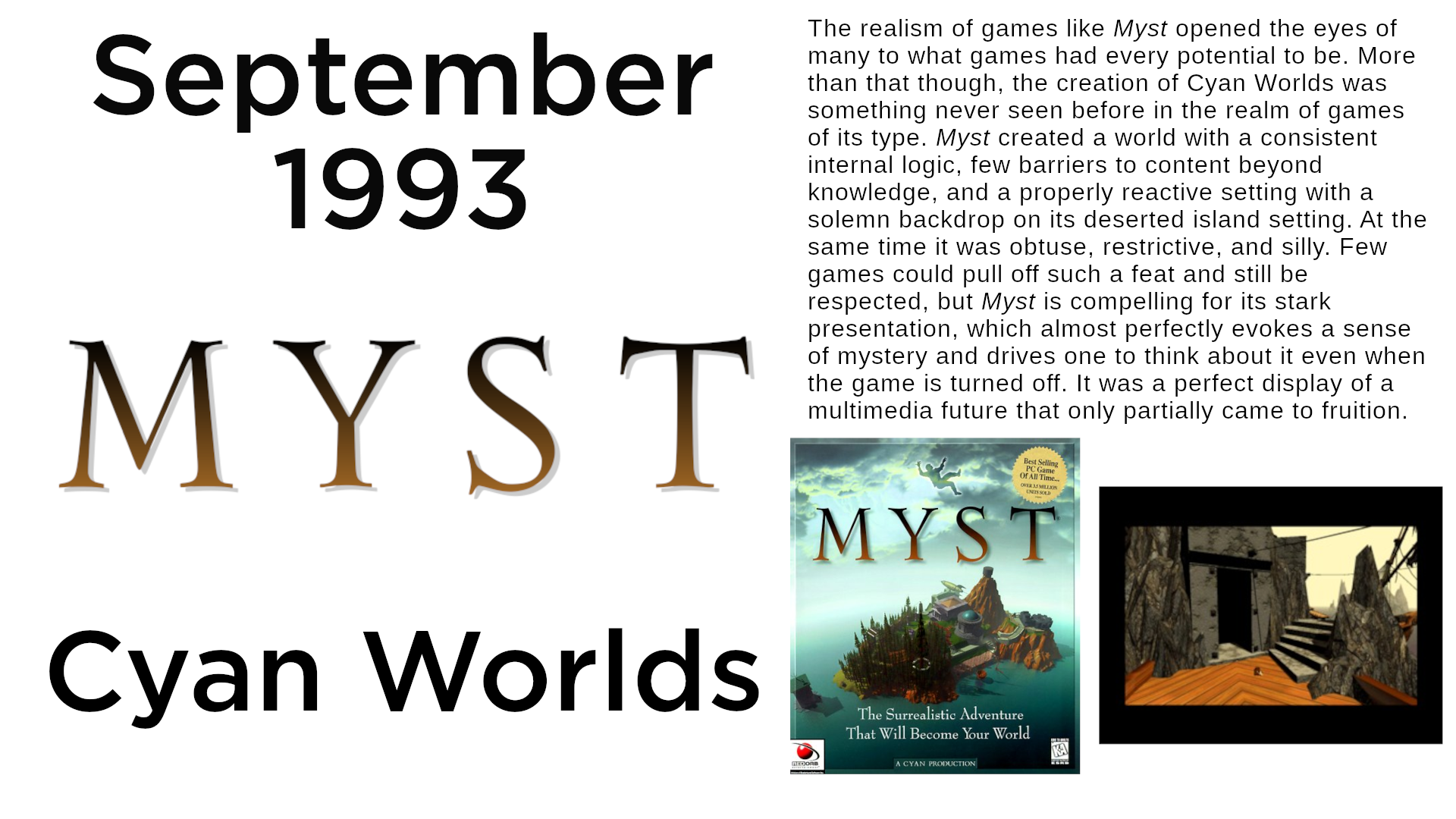
The realism of games like Myst opened the eyes of many to what games had every potential to be. More than that though, the creation of Cyan Worlds was something never seen before in the realm of games of its type. Myst created a world with a consistent internal logic, few barriers to content beyond knowledge, and a properly reactive setting with a solemn backdrop on its deserted island setting. At the same time it was obtuse, restrictive, and silly. Few games could pull off such a feat and still be respected, but Myst is compelling for its stark presentation, which almost perfectly evokes a sense of mystery and drives one to think about it even when the game is turned off. It was a perfect display of a multimedia future that only partially came to fruition.
Welcome these choices to the Video Game Notables! We’ll see you again this time next year for a new batch of six notable titles!







Don’t forget the groundbreaking game from the point & click genre… the good old Monkey Island. On that note, the D&D games of the caliber of Baldur’s Gate II shouldn’t be forgotten.